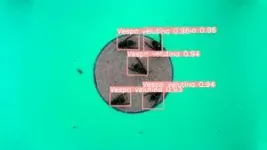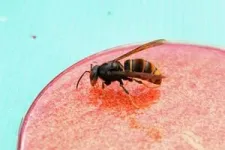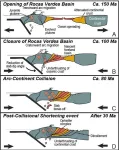(Press-News.org) If you imagine an industrial wind turbine, you likely picture the windmill design, technically known as a horizontal-axis wind turbine (HAWT). But the very first wind turbines, which were developed in the Middle East around the 8th century for grinding grain, were vertical-axis wind turbines (VAWT), meaning they spun perpendicular to the wind, rather than parallel.
Due to their slower rotation speed, VAWTs are less noisy than HAWTs and achieve greater wind energy density, meaning they need less space for the same output both on- and off-shore. The blades are also more wildlife-friendly: because they rotate laterally, rather than slicing down from above, they are easier for birds to avoid.
With these advantages, why are VAWTs largely absent from today’s wind energy market? As Sébastien Le Fouest, a researcher in the School of Engineering Unsteady Flow Diagnostics Lab explains, it comes down to an engineering problem – air flow control – that he believes can be solved with a combination of sensor technology and machine learning. In a paper recently published in Nature Communications, Le Fouest and UNFOLD head Karen Mulleners describe two optimal pitch profiles for VAWT blades, which achieve a 200% increase in turbine efficiency and a 77% reduction in structure-threatening vibrations.
“Our study represents, to the best of our knowledge, the first experimental application of a genetic learning algorithm to determine the best pitch for a VAWT blade,” Le Fouest says.
Turning an Achilles’ heel into an advantage
Le Fouest explains that while Europe’s installed wind energy capacity is growing by 19 gigawatts per year, this figure needs to be closer to 30 GW to meet the UN’s 2050 objectives for carbon emissions.
“The barriers to achieving this are not financial, but social and legislative – there is very low public acceptance of wind turbines because of their size and noisiness,” he says.
Despite their advantages in this regard, VAWTs suffer from a serious drawback: they only function well with moderate, continuous air flow. The vertical axis of rotation means that the blades are constantly changing orientation with respect to the wind. A strong gust increases the angle between air flow and blade, forming a vortex in a phenomenon called dynamic stall. These vortices create transient structural loads that the blades cannot withstand.
To tackle this lack of resistance to gusts, the researchers mounted sensors onto an actuating blade shaft to measure the air forces acting on it. By pitching the blade back and forth at different angles, speeds, and amplitudes, they generated series of ‘pitch profiles’. Then, they used a computer to run a genetic algorithm, which performed over 3500 experimental iterations. Like an evolutionary process, the algorithm selected for the most efficient and robust pitch profiles, and recombined their traits to generate new and improved ‘offspring’.
This approach allowed the researchers not only to identify two pitch profile series that contribute to significantly enhanced turbine efficiency and robustness, but also to turn the biggest weakness of VAWTs into a strength.
“Dynamic stall – the same phenomenon that destroys wind turbines – at a smaller scale can actually propel the blade forward. Here, we really use dynamic stall to our advantage by redirecting the blade pitch forward to produce power,” Le Fouest explains. “Most wind turbines angle the force generated by the blades upwards, which does not help the rotation. Changing that angle not only forms a smaller vortex – it simultaneously pushes it away at precisely the right time, which results in a second region of power production downwind.”
The Nature Communications paper represents Le Fouest’s PhD work in the UNFOLD lab. Now, he has received a Swiss National Science Foundation (SNSF) BRIDGE grant to build a proof-of-concept VAWT. The goal is to install it outdoors, so that it can be tested as it responds in real time to real-world conditions.
“We hope this air flow control method can bring efficient and reliable VAWT technology to maturity so that it can finally be made commercially available,” Le Fouest says.
This work benefited from the SNSF's "Assistant Professor (AP) Energy Grants" instrument. The call for proposals, launched between 2013 and 2016 as part of the Swiss government's Energy Strategy 2050, aimed to fund the launch of new energy-related research projects in newly opened laboratories. Read the SNSF press release. END
Machine learning enables viability of vertical-axis wind turbines
EPFL researchers have used a genetic learning algorithm to identify optimal pitch profiles for the blades of vertical-axis wind turbines, which despite their high energy potential, have until now been vulnerable to strong gusts of wind.
2024-04-03
ELSE PRESS RELEASES FROM THIS DATE:
E-cigarette users now more likely to quit traditional cigarettes
2024-04-03
A new paper in Nicotine & Tobacco Research, published by Oxford University Press, finds that smokers who switch to electronic cigarettes are now more likely to stop smoking regular cigarettes. In the past, smokers who began using electronic cigarettes mostly continued smoking.
Electronic nicotine delivery systems first emerged on the U.S. market in 2007. The first e-cigarettes resembled conventional cigarettes (in appearance) and used fixed low-voltage batteries. Beginning in 2016, manufacturers introduced e-liquids containing nicotine salt formulations. These new e-cigarettes became widely available. These nicotine salts are lower in pH than freebase formulations, which allow manufacturers ...
Chatbot guides women through post-prison challenges
2024-04-03
Most women leaving prison face profound disadvantages and rarely have access to the resources needed to settle back into the community. Seemingly simple tasks such as obtaining replacement identification documents or opening a bank account become tangled in complexities.
Now researchers at the University of South Australia are co-designing a chatbot to help formerly incarcerated women re-establish their lives on the outside, and reduce the risk of them returning to prison.
Led by a team of UniSA researchers in collaboration with advocacy group Seeds of Affinity, the tech-based solution aims to help women access trusted ...
Doctors on front line of tackling childhood obesity but more training and resources needed
2024-04-03
Doctors are feeling unable to tackle growing problem of childhood obesity due to a lack of training and capacity according to new research.
In a paper published in the British Journal of General Practice, researchers from the University of Birmingham conducted in-depth interviews with healthcare professionals (HCPs) to understand their experiences of supporting families to tackle childhood obesity.
One participant in the study said:
“I had one mum and her child was overweight, but she was a young parent and she actually didn’t know how to cook the dinners and, yeah… we spent a lot of time with her giving her ...
Galaxies get more chaotic as they age
2024-04-03
Galaxies start life with their stars rotating in an orderly pattern but in some the motion of stars in more random. Until now, scientists have been uncertain about what causes this – possibly the surrounding environment or the mass of the galaxy itself.
A new study, published in a paper today in MNRAS (Monthly Notices of the Royal Astronomical Society), has found that the most important factor is neither of these things. It shows the tendency of the stars to have random motion is driven mostly by the age of the galaxy – things just get messy over time.
“When we did the analysis, we found that age, consistently, whichever way we slice or dice it, is always the most ...
Sandia pumps $140B into the economy through technology development
2024-04-03
ALBUQUERQUE, N.M. — To say that the technology and products Sandia National Laboratories researchers have helped imagine, innovate and industrialize have had a massive impact on the country would be an understatement.
Two studies commissioned by Sandia and the National Nuclear Security Administration show Sandia’s work has had an overall economic impact of $140 billion since the year 2000. That’s a significant figure, especially considering it spans just 20 years, less than a third of Sandia’s 75-year existence.
“I am very proud of how Sandia excels in fulfilling its technology transfer mission to deliver economic impact to the U.S.,” ...
Even moderate alcohol usage during pregnancy linked to birth abnormalities, UNM researchers find
2024-04-03
University of New Mexico researchers have found that even low to moderate alcohol use by pregnant patients may contribute to subtle changes in their babies’ prenatal development, including lower birth length and a shorter duration of gestation.
In a new paper published in the journal Alcohol Clinical & Experimental Research, a team led by Ludmila Bakhireva, MD, PhD, MPH, professor and assistant dean for Clinical and Translational Research in the UNM College of Pharmacy, also reported some sex-related differences in the effects of drinking during pregnancy on the developing ...
Sylvester physician co-authors global plan to combat prostate cancer
2024-04-03
MIAMI, FLORIDA (EMBARGOED UNTIL APRIL 4, 2024, at 6:30 pm EDT) – Annual prostate cancer cases worldwide are projected to double by the year 2040, and annual deaths are projected to increase by 85% to almost 700,000 over the same timeframe – mainly among men in low- and middle-income countries. A commissioned report published online in The Lancet on April 4 highlights the future landscape of prostate cancer and seeks to guide cancer experts worldwide on how to manage the massive influx of prostate cancer patients projected over the next two decades.
Brandon Mahal, M.D., radiation oncologist and ...
Last chance to record archaic Greek language ‘heading for extinction’
2024-04-03
A new data crowdsourcing platform aims to preserve the sound of Romeyka, an endangered millennia-old variety of Greek. Experts consider the language to be a linguistic goldmine and a living bridge to the ancient world.
The initiative, led by Professor Ioanna Sitaridou from the University of Cambridge, contributes to the UN’s International Decade of Indigenous Languages (2022-32), which aims ‘to draw global attention on the critical situation of many indigenous languages and to mobilise stakeholders and resources for their preservation, revitalization and promotion.’
Romeyka is thought to have only a couple of thousand ...
Chicks prove vision and touch linked at birth
2024-04-03
Newly hatched chicks raised in darkness and allowed to touch either a smooth or bumpy cube for 24 hours instantly recognised the object with their vision upon first exposure to light.
This suggests chicks can link touch and vision without any prior experience combining these senses, challenging the long-held belief that such integration requires learning.
The discovery implies a pre-wired ability in the brain for cross-modal perception, potentially redefining our understanding of animal cognition and sensory processing.
In a study published in Biology Letters, researchers at Queen Mary University of London have cracked ...
Researchers propose new step in tectonic squeeze that turns seafloor into mountains
2024-04-03
Scientists use tiny minerals called zircons as geologic timekeepers. Often no bigger than a grain of sand, these crystals record chemical signatures of the geological environment where they formed. In a new study led by scientists at The University of Texas at Austin, researchers used them to describe what could be an overlooked step in a fundamental tectonic process that raises seafloors into mountains.
In a study published in the journal Geology, the researchers describe zircons from the Andes mountains of Patagonia. Although the zircons formed when tectonic plates were colliding, they have a chemical signature associated ...
LAST 30 PRESS RELEASES:
Decades of suffering: Long-term mental health outcomes of Kurdish chemical gas attacks
Interactional dynamics of self-assessment and advice in peer reflection on microteaching
When aging affects the young: Revealing the weight of caregiving on teenagers
Can Canada’s health systems handle increased demand during FIFA World Cup?
Autistic and non-autistic faces may “speak a different language” when expressing emotion
No clear evidence that cannabis-based medicines relieve chronic nerve pain
Pioneering second-order nonlinear vibrational nanoscopy for interfacial molecular systems beyond the diffraction limit
Bottleneck in hydrogen distribution jeopardises billions in clean energy
Lung cancer death rates among women in Europe are finally levelling off
Scientists trace microplastics in fertilizer from fields to the beach
The Lancet Obstetrics, Gynecology, & Women’s Health: Taking paracetamol during pregnancy does not increase risk of autism, ADHD or intellectual disabilities, confirms new gold-standard evidence review
Taking paracetamol during pregnancy does not increase risk of autism, ADHD or intellectual disabilities
Harm reduction vending machines in New York State expand access to overdose treatment and drug test strips, UB studies confirm
University of Phoenix releases white paper on Credit for Prior Learning as a catalyst for internal mobility and retention
Canada losing track of salmon health as climate and industrial threats mount
Molecular sieve-confined Pt-FeOx catalysts achieve highly efficient reversible hydrogen cycle of methylcyclohexane-toluene
Investment in farm productivity tools key to reducing greenhouse gas
New review highlights electrochemical pathways to recover uranium from wastewater and seawater
Hidden pollutants in shale gas development raise environmental concerns, new review finds
Discarded cigarette butts transformed into high performance energy storage materials
Researchers highlight role of alternative RNA splicing in schizophrenia
NTU Singapore scientists find new way to disarm antibiotic-resistant bacteria and restore healing in chronic wounds
Research suggests nationwide racial bias in media reporting on gun violence
Revealing the cell’s nanocourier at work
Health impacts of nursing home staffing
Public views about opioid overdose and people with opioid use disorder
Age-related changes in sperm DNA may play a role in autism risk
Ambitious model fails to explain near-death experiences, experts say
Multifaceted effects of inward foreign direct investment on new venture creation
Exploring mutations that spontaneously switch on a key brain cell receptor
[Press-News.org] Machine learning enables viability of vertical-axis wind turbinesEPFL researchers have used a genetic learning algorithm to identify optimal pitch profiles for the blades of vertical-axis wind turbines, which despite their high energy potential, have until now been vulnerable to strong gusts of wind.







